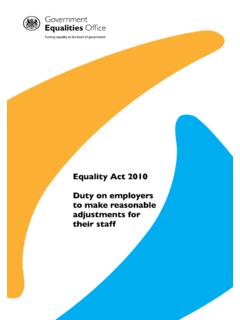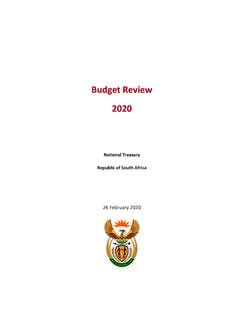Transcription of M. SECTION 457 DEFERRED COMPENSATION PLANS OF …
1 M. SECTION 457 DEFERRED COMPENSATION PLANS OF STATE AND LOCAL government AND TAX-EXEMPT employers by Cheryl Press and Robert Patchell 1. Introduction SECTION 457 PLANS are nonqualified, unfunded DEFERRED COMPENSATION PLANS established by state and local government and tax-exempt employers . These employers can establish either eligible (covered by 457(b)) or ineligible (covered by 457(f)) PLANS , and are subject to the specific requirements and deferral limitations of SECTION 457 of the Internal Revenue Code of 1986 ("Code"). Certain other types of PLANS established by state and local government and tax-exempt employers are not subject to the requirements of SECTION 457, however. The purpose of this article is to provide an overview of SECTION 457, identify the differences between an eligible and an ineligible SECTION 457 plan, and discuss those PLANS which are excepted from the rules and requirements articulated in SECTION 457 and the regulations thereunder.
2 This article will also try to highlight specific situations where PLANS may not be in compliance with SECTION 457. As originally enacted, the rules governing SECTION 457 PLANS were developed based on nonqualified plan concepts. SECTION 457 PLANS therefore are subject to different, and often less stringent regulations than are funded, qualified PLANS , which must comply with complex rules to assure parity in who they cover, and how much can be DEFERRED . An attendant feature of SECTION 457 PLANS is that they may provide less security to participants than do qualified PLANS . 2. SECTION 457(b) "Eligible" DEFERRED COMPENSATION PLANS SECTION 457(a) of the Code permits a participant to defer COMPENSATION to a DEFERRED COMPENSATION plan of an "eligible employer," provided that the plan satisfies the eligibility requirements of SECTION 457.
3 Under SECTION 457(a), COMPENSATION DEFERRED pursuant to an eligible plan and the income attributable to such DEFERRED COMPENSATION , are taxable in the year in which the DEFERRED amounts are paid or made available to a plan participant or other beneficiary. SECTION 457 DEFERRED COMPENSATION PLANS of State and Local government A. Eligible employers An eligible DEFERRED COMPENSATION plan is defined as any plan, agreement or other arrangement that is established and maintained by an "eligible employer". Sections 457(b), 457(f)(3)(A). The term eligible employer is defined as a State (including the District of Columbia), political subdivision of a State, any agency or instrumentality of a State or political subdivision of a State, and any other organization (other than a government unit) exempt from tax under subtitle A of the Code.
4 SECTION 457(e)(1), SECTION (c) of the Regulations. SECTION 457 therefore applies to all tax-exempt employers that maintain a DEFERRED COMPENSATION plan, except churches, which are specifically excluded under SECTION 457(e)(13). The application of SECTION 457 to DEFERRED compensa tion PLANS of exempt organizations became effective under the Tax Reform Act ("TRA") of 1986. DEFERRED COMPENSATION PLANS of agencies and instrumen talities of the Federal government are not subject of SECTION 457. B. Who May Participate in an Eligible Plan under SECTION 457(b)(1)? (1) In General Only individuals who perform services for the entity, either as employees or independent contractors, may be participants in a SECTION 457 plan. SECTION 457(e)(2), (d). Corporations cannot be participants in a plan.
5 (2) Select Group of Employees of Non-governmental Tax-exempt Entities While any employee or independent contractor of a governmental entity can be a participant, tax-exempt organizations that are non- governmental must limit participation to management and highly compensated employees . This is because of the rules under the Employee Retirement Income Security Act of 1974 ("ERISA"), which contains the applicable pension regulations under the jurisdiction of the Department of Labor. ERISA generally requires that a plan which provides retirement benefits to employees must be funded by an irrevocable trust. SECTION 457 PLANS also provide such benefits. However, the rules of SECTION 457 require such PLANS to be unfunded in order to obtain tax benefits. Therefore, an entity cannot attain tax deferral for its employees under a SECTION 457 plan unless an exception to the funding requirement applies.
6 government PLANS are expressly exempt from the funding requirements of ERISA. Other tax-exempt employers may main tain SECTION 457 PLANS , but only for management and highly compensated 190 SECTION 457 DEFERRED COMPENSATION PLANS of State and Local government employees, as the funding rules under ERISA do not apply to a "top hat" plan, a type of plan which specifically covers these types of employees. If the covered employees do not fall into these exceptions, the PLANS must be funded PLANS subject to the rules of ERISA. SECTION 457 PLANS are not subject to the nondiscrimination rules, with which funded, qualified PLANS must comply. These rules are designed to insure that the highly compensated employees of an employer do not receive a dispropor tionate share of the benefits under qualified PLANS maintained by the employer.
7 Neither the ERISA coverage rules nor the Code s coverage and nondiscrimina tion rules apply to unfunded top-hat PLANS , and no discrimination issue is raised by eliminating all rank and file employees from coverage under eligible 457 PLANS . In fact, SECTION 457 PLANS of tax-exempt employers must do just that in order to be eligible PLANS . In contrast, qualified PLANS are developed for the rank and file as well as for highly compensated employees. C. Maximum Deferral Limitations under Sections 457(b)(2) and (3); Coordination Limitation under SECTION 457(c)(2) (1) General Rule Under SECTION 457(b)(2), a plan must provide that the annual amount that can be DEFERRED is limited to the lesser of $7500, or 33 1/3% of a participant s "includible COMPENSATION ". The $7500 limit includes both employer contribu tions and employee salary reduction deferrals.
8 (2) "Includible COMPENSATION " "Includible COMPENSATION " for a taxable year includes only COMPENSATION attributable to services performed for the employer which is currently included in the participant s gross income for the taxable year, after taking into account amounts DEFERRED (or otherwise not currently included in gross income) under SECTION 457 and other provisions of the Code. SECTION 457(e)(5), SECTION (e)(2) of the Regulations. These other Code sections under which COMPENSATION is not includible in gross income include SECTION 401(k) cash or DEFERRED arran gements (CODAs or 401Ks), SECTION 402(h)(1)(B) simplified employee pensions (SEPs) and SECTION 403(b) tax-sheltered annuities (TSAs). The legislative history of SECTION 457 indicates that in a typical arrangement, the 33 1/3% of includible COMPENSATION limitation is equal to 25% of the COMPENSATION that would have been received but for the salary reduction agreement.
9 The amount of includible COMPENSATION is determined without regard to any community property laws. SECTION 457(e)(7). 191 SECTION 457 DEFERRED COMPENSATION PLANS of State and Local government Amounts payable on separation from service for unused sick and vacation leave accrued in prior years may not be DEFERRED under an eligible plan pursuant to an election made in the final year of service, although these amounts would be used for determining includible COMPENSATION . (3) Example The following brief example illustrates how the deferral limitation operates to limit the amount of includible COMPENSATION that may be DEFERRED under SECTION 457(b). An employee who is scheduled to receive $24,000 during a taxable year could enter into a salary reduction agreement and elect to defer $6,000 for that year and be within the deferral limitation under 457(b), because this amount is equal to 25% of the employee s gross COMPENSATION of $24,000 and 33 1/3% of his or her includible COMPENSATION of $18,000 ($24,000 - $6,000).
10 (4) Catch-up Rule An exception to the general deferral limitation under SECTION 457(b)(2) does exist, however. Under SECTION 457(b)(3), an eligible plan may provide that for one or more of a participant s last three taxable years ending before the attainment of retirement age, the amount which may be DEFERRED is increased to the lesser of (A) $15,000, or (B) the sum of (i) the plan ceiling for purposes of 457(b)(2), plus (ii) so much of the plan ceiling established for purposes of 457(b)(2) for taxable years before the taxable year as has not previously been used under 457(b)(2) or 457(b)(3). (Catch-up Limitation). With respect to the underutilized limitations and the limited catch-up rule, SECTION (f)(2) of the Regulations provides, in part, that a prior year is taken into account only if (A) it begins after December 1, 1978, (B) the par ticipant was eligible to participate in the plan during all or a portion of the taxable year, and (C) COMPENSATION DEFERRED (if any) under the plan during the taxable year was subject to the plan ceiling established under (e)(1).


















